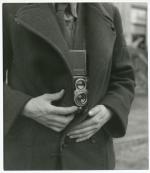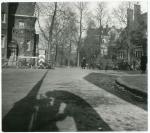
The Underground Camera
Although there was no general ban on photography in the Netherlands during the German occupation, with the exception of Sperr areas, until late 1944, it was risky to photograph things the occupying forces did not like. During the last year of the war, resistance fighters Tony van Renterghem, chief of staff of the Internal Armed Forces in Amsterdam South, and German-Jewish filmmaker Fritz Kahlenberg approached Dutch photographers active in Amsterdam and its surroundings. Their aim was to capture the conditions of the occupation as testimony for later. Shots of the miserable living conditions in the West during the 1944/1945 Hunger Winter were also taken and transferred to London to convince the Dutch government in exile to advocate food drops to the Allies.
During the war, the group of photographers operated under the neutral name ‘Nederland Archief’ (Netherlands Archive). After the war, the group of photographers became best known under the name ‘De Ondergedoken Camera’ (The Underground Camera ). Its contributors included young photographers who would achieve great fame after the war such as, Cas Oorthuys, Carel Blazer, Marius Meijboom, Ad Windig, Charles Breijer, Kryn Taconis and Emmy Andriesse.
Photos by the group ‘De Ondergedoken Camera’ contributed significantly to the portrayal of the German occupation after the war. However, little is known about the nature and scope of these photographers' work; what subjects were captured, how was the group organised, and how did the group's leadership operate from its hiding place in Amsterdam South. In the attic of the hiding house, the remains of where the dark camera was set up at the time can still be seen.
In spring 2025, the project will be completed with a book publication.
